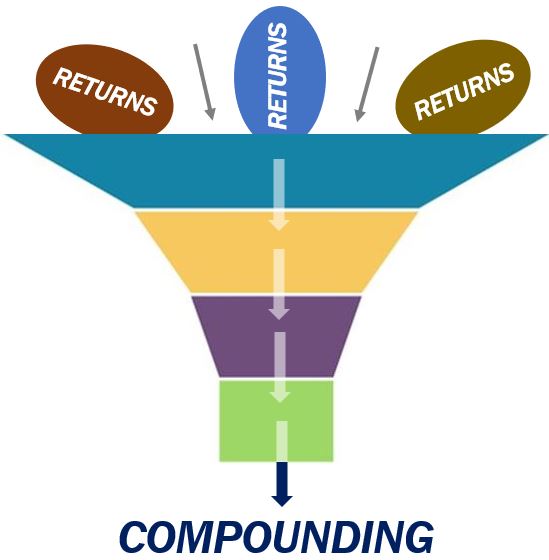What does Compounding mean in Investments?

Have you heard about the magic of compounded growth? In case you have not, understand that “compounding” is a term used to explain how money can grow over time. This magic is significant only over long periods of time — 20 to 30 years or longer; and for this reason it is advisable that you start saving and investing early in your life, say in the 20s or 30s. Why? Simply because if you wait ten years before you start, you will substantially reduce your investment return which would be hard to make up. This difference can only be made up if you have a much larger savings rate and save for an even longer period.
Probably, you would have heard what Einstein said about compound interest – “the greatest mathematical discovery of all time”, and he could not have been more right. The “magic of compounding” is based on the formula of time and reward; the longer the time period, the greater the power of compounding investment returns. Whatever your initial investment be; even a series of modest annual investments will do; you can get a great terminal value if you invest your money at the right time, and at the right rate.
How does Compounding work?
People think it is enough to invest every once in a while only when they have “extra” money. But irregular habits of saving and investing will lead to small benefits only. If you want high returns, you need to invest regularly, and from an early age. The sooner you begin investing, the more money you will be able to invest, and the greater will be your overall returns because of compounding.
In a savings account, your savings increase linearly with time while in compounding, the value of your investment increases exponentially over time. When your investments are compounded, your financial returns from your investment are added back into the original investment. The power of compounding is truly amazing; from a banking perspective, compounding provides strength and value creation, if performed in the right manner. Favorable compounded growth is guided by three factors
- the progression of time
- a high growth rate, and
- consistency.
The Power of Compounded Returns and Mutual Funds
By now it would be clear to you that the earlier you start saving, the longer your money benefits from compounding, so you can start by investing small amounts too. As your contributions will accumulate over time and generate interest, your savings will compound; this means that the interest you generated from your savings will get added to your savings and increase the amount of interest your account generates. The impact of this effect accelerates with the passage of time. When you need to combine total return figures for multiple periods, it is important to compound the returns by multiplying them together. If you simply add them up, you will obtain a misleading result, especially when large gains or losses are involved. For example, if a fund loses 30% in one year, then gains 30% in the next, adding them up results in -30 + 30 = 0, i.e. no net change, which is not true.
Almost all discussions of compound interest and future value depends on four factors:
- The constancy of interest rates
- The nominal annual rate of interest
- The number of times per year interest is paid
- The number of periods for which interest is compounded
How to compound your money successfully?
- Invest More Now: The bigger your initial investment, the faster you will reach your target.
- Increase Your Monthly Contributions: Investing a small amount more each month will move you more quickly to your goal.
- Make a Long Term Investment: A longer time period will create the opportunity for additional compounding of your returns.
If the difference between a cheap and an expensive fund only added up to a few 100 rupees after 40 years, no one would have stressed. It is the power of compounding interest that makes small sums grow very large over time, and this makes all the difference. Even if you are in your 20s, start investing, even if you invest only a small amount. Nourished by the miracle of compound interest, your portfolio should flourish with the market’s passing cycles.
For example, over a 10-year period, if market returns average a nominal 10 percent annually, an initial investment of $ 10,000 will grow to almost $ 26,000, more than two and a half times the initial investment. In case of mutual funds, you should judge a bond fund by its yield and evaluate its total return i.e. its yield plus any capital appreciation plus compounding of those gains over time.
Things to remember when your Aim is Compounding the Right Way:
- To exploit the full power of compounding in real markets, pay particular attention to the negative implications of cost such as the cost of investment advice, portfolio management and administration, buying and selling investments, and taxes.
- Even small differences in annual returns, extended over long periods of time, will make a dramatic difference in how much capital you finally accumulate. Give your portfolio plenty of time to benefit from the magic of compounding.
- Compounding is a long-term investment strategy that can reward you significantly. Those mutual fund investors who deviate from the long-term investing ideal are only partially rewarded.
- Remember that because of the impact of compounding, the gap between the capital that is attainable and the capital that is actually created increases rapidly.
As an investor, what do you want at the end of the day?
You expect your business to grow. For this reason, compound growth is your most valuable tool. Use compounding the right way; see your business multiply, then you will yourself say, “Mutual Fund sahi hai!”

